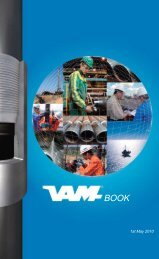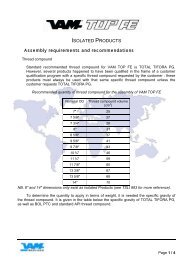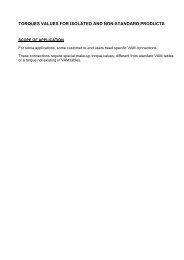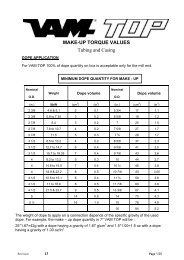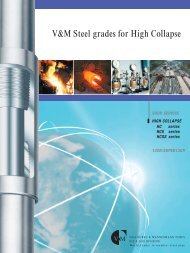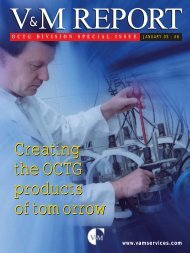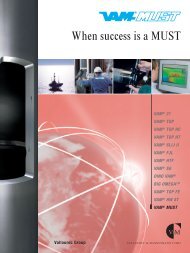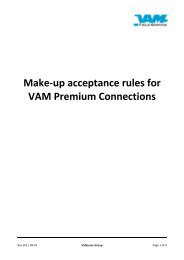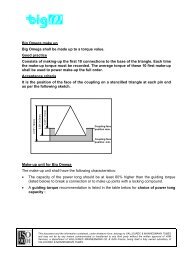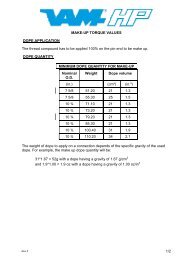Create successful ePaper yourself
Turn your PDF publications into a flip-book with our unique Google optimized e-Paper software.
V&M <strong>13%</strong> Cr & Super <strong>13%</strong> Cr steel grades<br />
for Sweet CO 2 corrosion service<br />
SOUR SERVICE<br />
HIGH COLLAPSE<br />
13<strong>CR</strong>/SUPER13<strong>CR</strong><br />
VM 80 13Cr<br />
VM 90 13Cr<br />
VM 95 13Cr<br />
VM 95 13CrSS<br />
VM 110 13CrSS<br />
VM 80 13ET<br />
Vallourec Group
<strong>13%</strong> Cr & Super <strong>13%</strong> Cr V&M grades<br />
Higher Performances V&M <strong>CR</strong>A grades<br />
V&M TUBES offers also a full range of proprietary <strong>CR</strong>A materials for the more stringent corrosive<br />
environments. It includes the main OCTG duplex, super duplex, super austenitic and nickel base<br />
alloys like :<br />
• VM 22<br />
• VM 25<br />
• VM 25S<br />
• VM 28<br />
• VM 825<br />
• VM G3<br />
• VM 50<br />
}<br />
22%Cr duplex steel<br />
25%Cr duplex steel<br />
25%Cr super duplex steel<br />
28%Cr super austenitic steel<br />
Nickel base alloys
V&M TUBES offers the best of OCTG suitable for Sweet CO 2 environment with limited H 2 S presence. It<br />
covers the requirements and parameters of such inhospitable conditions including high pressures, high<br />
temperatures and more. More than anywhere else, reliability is paramount and V&M TUBES provides<br />
the required top-of-the-class expertise and know how.<br />
Full range of products<br />
• Size range for OCTG: 2 3/8”to 10 3/4”<br />
• Wall Thickness up to 1”<br />
• Yield Strength: 80 to 110 ksi<br />
• Grades: API and V&M proprietary grades<br />
• <strong>13%</strong> Cr and Super <strong>13%</strong> Cr<br />
• <strong>VAM</strong> ® Premium connections<br />
• Tailor made products: Non standard OD and weight upon<br />
request<br />
BENEFITS<br />
• Large range of products<br />
• Reliable quality and leadtime<br />
• Long term expertise<br />
• Single source of your complete solution<br />
• <strong>VAM</strong> ® premium connections<br />
Integrated pipe manufacturer<br />
Expertise and know-how<br />
• Design, process and control of proprietary steel chemistries<br />
• 1 steel mill in France and several pipe mills in France, Germany,<br />
USA, Brazil dedicated to the production of OCTG goods<br />
• Connection threading integrated to the pipe mills or strategically<br />
located to serve a market<br />
• In house metallurgical testing and Non-Destructive<br />
Examination<br />
• Three R&D laboratories with more than 20 engineers and<br />
technicians dedicated to the design of improved steel chemistries<br />
• Capacity to perform more than 600 corrosion tests per month<br />
• All-in-one technical support: Pipe, material, <strong>VAM</strong> ® Premium<br />
connection and services<br />
Supply Chain Management<br />
Reliable Products and <strong>Services</strong><br />
• Proprietary <strong>13%</strong> Cr and Super <strong>13%</strong> Cr grades with tighter<br />
tolerances than API<br />
• Extensive data bank for various <strong>13%</strong> Cr and Super <strong>13%</strong> Cr<br />
specific tests conditions<br />
• Best-in-class quality control plan, including technologies with<br />
improved sensitivity to defects and enhanced control frequency<br />
• Full service provider: From steel making to pipe run<br />
in your well<br />
• Reduced lead time thanks to NACE testing parallel to<br />
manufacturing process<br />
• Extensive <strong>VAM</strong> ® licensee network for field repairs or accessories<br />
• <strong>VAM</strong> ® Field Service International: Inspection and running<br />
services
Sweet CO 2 service grades<br />
CO 2 corrosion in OCTG<br />
The growing demand of energy has resulted in a general need to<br />
produce fields with a tangible CO 2 content.<br />
The presence of corrosive species such as CO 2 , H 2 S, organic acids,<br />
O 2 and chlorides has a pronounced effect on corrosion in producing<br />
wells. Carbon dioxide is almost always present and its effect<br />
on corrosion is primarily by decreasing the pH of the water<br />
phase. Carbon dioxide instigates general corrosion, localized corrosion<br />
or formation of hard iron carbonate scales.<br />
For the last 25 years, the use of <strong>13%</strong> Cr seamless steel pipes has<br />
been the most cost effective solution to protect against sweet wet<br />
CO 2 corrosion.<br />
2. Standard recommendations<br />
The physical phenomenon associated with a sweet wet CO 2 corrosion<br />
is known as the uniform corrosion or the weight loss. In<br />
given conditions it has been demonstrated that the addition of a<br />
sufficient quantity of chromium in a steel alloy can dramatically<br />
reduce and even stop this phenomenon. Advanced <strong>13%</strong> Cr stainless<br />
steels were developed in the 1970s, with martensitic microstructures.<br />
More recently, “Super”<strong>13%</strong> Cr alloys were developed,<br />
with improved resistance to certain forms of corrosion: They<br />
combine low carbon content and additions of Ni and Mo.<br />
Table of main elements<br />
NACE MR0175/ISO 15156-3 2 , API 5CT/ISO 11960 3 and ISO<br />
13680 4 international standards define the rules of selection and<br />
the material specifications for martensitic and super martensitic<br />
stainless steels.<br />
1. Mechanism of wet CO 2 corrosion<br />
Corrosion arises because CO 2 gas dissolves into produced water.<br />
Therefore, the main parameters driving CO 2 corrosion are:<br />
• actual CO 2 partial pressure (or maximum value at the bubble<br />
pressure in oil wells),<br />
• actual pH of the water phase,<br />
• actual temperature,<br />
• weak acids,<br />
• flow rate (for carbon and low alloy steel only).<br />
3. Corrosion resistance<br />
As shown on the picture below, carbon steel is subject to drastic<br />
general and local CO 2 corrosion while <strong>13%</strong> Cr alloy remains protected<br />
thanks to its passive layer.<br />
CO 2 corrosion is related to the chemical reactions associated with<br />
the produced water.<br />
CO 2 (gas) + H 2 O ➞ CO 2<br />
(dissolved)<br />
CO 2 (dissolved) + H 2 O ➞ H 2 CO 3 ➞ H+ + HCO 3<br />
The overall mechanism (described by De Waard and Milliams 1 )<br />
when CO 2 gas is in contact with steel is:<br />
2(H + + HCO 3 - ) + Fe ➞ Fe ++ + 2HCO 3 - + H 2<br />
It induces several types of corrosion attacks on steel materials.<br />
A lot of parameters may change the intensity and the speed of the<br />
above general mechanism.<br />
Compilation of reference papers 5 , 6 shows the evolution of the<br />
corrosion rate versus temperature and chloride content.<br />
The next graph displays the corrosion rate of a 5 1/2”17 lb/ft.<br />
tubing in a sea water as a function of time. It illustrates the life<br />
expectancy of the tubing, based on a 50% wall thickness loss as
an acceptable limit. That graph clearly highlights the advantageous<br />
effect of <strong>13%</strong> Cr.<br />
T (°F)<br />
CO 2 Partial Pressure: CO 2 content determines the acidic conditions.<br />
Then the higher the CO 2 Partial Pressure the lower the corrosion<br />
resistance is.<br />
T (°C)<br />
CO 2 corrosion acts both through general weight loss and through<br />
acute localized attacks.<br />
Localised corrosion of carbon steel consists of severe and deep dissolution<br />
of the metal at discrete areas. Three main forms are<br />
known:<br />
• Pitting (no or moderate flow conditions)<br />
• Mesa Attack (through unstable carbonate protective layer)<br />
• Flow Induced (reinforced by high flowing conditions)<br />
P CO 2 (PSI)<br />
Temperature: The temperature is linked to the kinetics of the chemical<br />
reactions. An increase limits the corrosion resistance.<br />
T (°F)<br />
T (°C)<br />
pH: As pH is mainly dictated by CO 2 Partial Pressure, the decrease<br />
of pH will decrease the corrosion resistance.<br />
Example of CO 2 corrosion of Carbon Steel OCTG pipe<br />
4. Limits of corrosion resistance<br />
Field case histories provide the most reliable data base for the measurement<br />
of the efficiency of a material within a corrosive reservoir.<br />
Using such a V&M TUBES data base, our experts can analyse all<br />
the parameters in the well environment.To help their diagnosis, the<br />
effects of the main factors which provoke sweet corrosion have been<br />
studied in laboratory.<br />
Chloride content: Recent studies have shown that the chloride<br />
content has a detrimental effect on the passivation layer. This leads<br />
to a decrease in the corrosion resistance.<br />
pH
Sweet CO 2 service grades<br />
water the content will be about 1,000 ppm chloride without<br />
bicarbonates leading to a pH value between about 3.2 and 3.5 in<br />
this case.<br />
6. <strong>13%</strong> Cr Alloys Selection guidelines<br />
Chloride (ppm)<br />
The table below give some guidance to steel selection. That chart is<br />
conservative and has been based on a“worst case”philosophy.<br />
A full knowledge of the specific oilfield environment will often<br />
allow a larger range of use of the V&M steels.<br />
5. Sulfide Stress Cracking resistance<br />
The first standard published by NACE in 1975 defined Sour<br />
Service 7 conditions above a threshold of Partial Pressure H 2 S of<br />
0.05 psi. NACE MR0175 / ISO 15156 standard has since emerged<br />
and defines Sour Service domains as a function of the Partial<br />
Pressure H 2 S and the in-situ pH.<br />
The NACE / ISO standard limits the use of <strong>13%</strong> Cr alloys at a<br />
maximum H 2 S partial pressure of 1.5 psi and pH ≥ 3.5. Crolet /<br />
Kermani in their paper 8 define a wider domain of non sour service<br />
for L80 <strong>13%</strong> Cr if the actual yield strength of pipes is appropriate<br />
(green colour on the figure below). V&M TUBES’ recommendation<br />
is to perform SSC tests according to well conditions with<br />
Partial Pressure H 2 S between 0.15 and 14.5 psi and pH above<br />
3.5 (red-green dotted area of the graph below).<br />
7. Handling and storage<br />
Note: According to the Fit-For-Purpose approach and since chloride<br />
content is an important parameter, two typical environments<br />
such as formation and condensed waters may be used for assessing<br />
the corrosion resistance of martensitic stainless steels. While formation<br />
water originates in the various geological horizons of oil<br />
and gas reservoirs, condensed water is produced in the tubing as<br />
the pressure and the temperature decrease.As mentioned in the literature<br />
a typical formation water extracted with the oil and gas<br />
effluent contains chloride ions with concentrations up to about<br />
200,000 ppm with pH values close to 4.5. For a typical condensed<br />
As a general rule pipe shall be stored and handled in accordance<br />
with API RP 5C1 9 “Recommended Practice for Care and Use of<br />
Casing and Tubing”.<br />
<strong>13%</strong> Cr and Super <strong>13%</strong> Cr materials are sensitive to pitting initiated<br />
by confined or trapped humidity with the presence of chlorides.<br />
Nevertheless they do not suffer from routine rinsing (rain)<br />
providing that they are properly packed and stacked.<br />
V&M TUBES ensures the condition of its <strong>13%</strong> Cr goods by the<br />
use of appropriate procedures that cover the packaging, temporary<br />
protection, storage and transportation of its products.
8. Competitiveness of <strong>13%</strong> Cr alloys<br />
<strong>13%</strong> Cr pipe presents a greater<br />
initial investment than carbon<br />
steel.<br />
However, this effect is balanced<br />
by the higher Operational<br />
Expenditure of chemical inhibition<br />
or work over when carbon<br />
steels are used in sweet CO 2 environments.<br />
In many cases the economics presented by well environments<br />
and applications lead clearly to financial<br />
advantages of <strong>13%</strong> Cr materials over carbon steel<br />
and inhibitors.<br />
9. Corrosion expertise<br />
10. First class processing<br />
<strong>13%</strong> Cr and Super <strong>13%</strong> Cr steel elaboration is processed in our<br />
Saint-Saulve steel plant in France or by expert steels maker partners.<br />
Equipments include electrical furnaces fed from scrap, blast<br />
furnaces fed with iron ore, vacuum degassing batches, continuous<br />
cast to produce steel rounds and forging equipment.<br />
The <strong>13%</strong> Cr and Super <strong>13%</strong> Cr pipe is produced in four mills in<br />
France, Brazil and Germany. Overall capacity reaches up to forty<br />
thousand tons per year. Equipments include:<br />
• Advanced hot-rolled processes: Pilger mill, continuous mandrel<br />
mills, plug rolling mills, MPM mill,…<br />
• Heat treatments with computer controlled austenitizing and<br />
tempering furnaces, internal or external quenching units.<br />
• Non-destructive evaluation on or off line, including the latest<br />
ultra sonic technology like phased-array, capturing smallest<br />
defects, and C-Scan.<br />
Pipe finishing for the OCTG market includes full length mill<br />
threading and stock management in nine facilities around the<br />
world, in France, Germany, UK, USA, Canada, Mexico, Brazil<br />
and Indonesia, a <strong>VAM</strong> ® Licensee network of more than one hundred<br />
accessory and repair shops around the world and a quality,<br />
documentation and gauge rental system managed by our <strong>VAM</strong> ®<br />
<strong>Services</strong> department.<br />
11. Field records<br />
V&M TUBES has been involved in all the different types of<br />
sweet CO 2 applications all around the world during the last thirty<br />
years. Do not hesitate to ask us for a reference or a field<br />
records’list.<br />
12. References<br />
There are more than twenty scientists and material experts working<br />
in our three Research & Development laboratories located in<br />
France and Germany. Their expertise in pipe corrosion prevention<br />
is based on more than fifty years of work with the Oil & Gas<br />
industry.<br />
Our laboratories are equipped with efficient CO 2 and H 2 S corrosion<br />
investigation tools such as electrochemical and autoclave<br />
equipments.<br />
V&M TUBES is happy to aid your selection process and to<br />
demonstrate its validity.<br />
1 C. de Waard and D.E. Milliams “Carbonic acid corrosion of steel”, Corrosion<br />
1975, 31, 131<br />
2 NACE MR0175 / ISO 15156-3“Petroleum and natural gas industries –<br />
Materials for use in H 2 S-containing environments in oil and gas production –<br />
Part 3: Cracking-resistant <strong>CR</strong>As (Corrosion ResistantAlloys) and other alloys”,<br />
First Edition, December 15, 2003<br />
3 API 5CT / ISO 11960“Petroleum and natural gas industries – Steel pipes for<br />
use as casing or tubing for wells”, Eighth Edition, July 1, 2005<br />
4 ISO 13680 “Petroleum and natural gas industries – Corrosion-resistant alloy<br />
seamless tubes for use as casing, tubing and coupling stock – Technical delivery<br />
conditions”, First Edition, July 1, 2000<br />
5 EFC #13“Predicting CO 2 corrosion in the Oil and Gas industry”, 1994<br />
6 EFC #23“CO 2 corrosion control in Oil and Gas production”, Edited by M. B.<br />
Kerrmani and L. M. Smith, 1997<br />
7 “V&M Steel grades for Sour Service”leaflet, 2004<br />
8 M.B. Kermani and D. Harrop – B.P. Research, M.L.R. Truchon and J.L. Crolet<br />
– Elf-Aquitaine “Experimental limit of Sour Service for Tubular Steels”,<br />
Corrosion91, Paper #21, 1991<br />
9 API RP 5C1“Recommended Practice for Care and Use of Casing and Tubing”,<br />
Eighteenth Edition, May 1999
Our worldwide network for your success<br />
Canada<br />
USA<br />
Scotland<br />
France<br />
Germany<br />
Russia<br />
Azerbaijan<br />
China<br />
V&M OIL & GAS UK<br />
V&M RUS<br />
<strong>VAM</strong> ® CANADA<br />
V&M OIL & GAS FRANCE<br />
V&M DEUTSCHLAND<br />
<strong>VAM</strong> ® CASPIAN<br />
V&M BEIJING<br />
<strong>VAM</strong> ® MEXICO<br />
<strong>VAM</strong> ® USA<br />
V&M TUBES<br />
<strong>VAM</strong> ® DUBAÏ<br />
VMOG NIGERIA<br />
<strong>VAM</strong> ® FAR EAST<br />
V&M DO BRASIL<br />
<strong>VAM</strong> ® ANGOLA<br />
Sales offices<br />
Steel making plants<br />
Manufacturing plants<br />
Accessories and repair<br />
<strong>VAM</strong> ® licensee facilities<br />
<strong>VAM</strong> ® Field Service<br />
International<br />
Mexico<br />
Brazil<br />
Nigeria<br />
Angola<br />
UAE<br />
Indonesia<br />
Singapore<br />
SALES OFFICES<br />
VALLOUREC MANNESMANN<br />
OIL & GAS FRANCE<br />
27, avenue du Général Leclerc<br />
92660 Boulogne Billancourt Cedex<br />
France<br />
Phone +33 1 49093731<br />
Fax +33 1 49093713<br />
V&M DEUTSCHLAND<br />
Oil & Gas Division<br />
Theodorstrasse 90<br />
40472 Düsseldorf, Germany<br />
Phone +49 211 960-0<br />
Fax +49 211 960-3924<br />
VALLOUREC MANNESMANN<br />
OIL & GAS UK<br />
Prospect Place<br />
Westhill Industrial Estate, Westhill<br />
Aberdeenshire, UK - AB32 6SY<br />
Phone +44 1224 279340<br />
Fax +44 1224 279341<br />
V&M TUBES<br />
1990 Post Oak Blvd, Suite 1400<br />
Houston, TX 77056-3813, USA<br />
Phone +1 713 4793200<br />
Fax +1 713 4793201<br />
V&M BEIJING<br />
Room 301, East Ocean Center<br />
24A, Jianguomenwai Avenue<br />
Beijing 100004, P.R. China<br />
Phone +86 10 5923 3000<br />
Fax +86 10 59 23 3001<br />
VALLOUREC & MANNESMANN RUS<br />
Office E02-305<br />
4 th Dobryninsky pereulok, 8,<br />
Moscow, 119049, Russia<br />
Phone +7 495 787-49-30<br />
Fax +7 495 787-49-31<br />
VALLOUREC MANNESMANN<br />
OIL & GAS NIGERIA<br />
15B Akanbi Danmola Street<br />
South West Ikoyi, Lagos, Nigeria<br />
Phone +234 1 463 0840<br />
Fax +234 1 463 0841<br />
SALES & SERVICES<br />
OFFICES<br />
V&M DO BRASIL<br />
Rua Lauro Müller 116 - Sala 1906<br />
Botafogo 22290 -160<br />
Rio de Janeiro - RJ, Brazil<br />
Phone +55 21 38738300<br />
Fax +55 21 38738316<br />
<strong>VAM</strong> USA<br />
19210 Hardy Road<br />
Houston, TX 77073, USA<br />
Phone +1 281 8215510<br />
Fax +1 281 8217760<br />
<strong>VAM</strong> CANADA<br />
# 1920, 444<br />
5 th Avenue SW, Calgary, Alberta<br />
Canada T2P 2T8<br />
Phone +1 403 2330119<br />
Fax +1 403 2662332<br />
<strong>VAM</strong> MEXICO<br />
Av. Framboyanes Lote 6<br />
Manzana 5<br />
Cd. ind. Bruno Pagliai<br />
Tejeria, Vera Cruz<br />
CP 91697, Mexico<br />
Phone +52 229 989 8716<br />
Fax +52 229 981 0349<br />
<strong>VAM</strong> DUBAI<br />
World Trade Center<br />
Level 14, office 14:01<br />
P.O. Box 9405<br />
DUBAI, U.A.E.<br />
Phone +971 4 329 16 18<br />
Fax +971 4 329 16 22<br />
SERVICES OFFICES<br />
<strong>VAM</strong> FIELD SERVICE<br />
INTERNATIONAL<br />
Prospect Place<br />
Westhill Industrial Estate, Westhill<br />
Aberdeenshire, UK - AB32 6SY<br />
Phone +44 1224 279380<br />
Fax +44 1224 279384<br />
<strong>VAM</strong> FAR EAST<br />
No. 16, Jalan Kilang Timor<br />
#06-05, Redhill Forum<br />
Singapore 159308<br />
Phone +65 6736 23 72<br />
Fax +65 6235 11 26<br />
<strong>VAM</strong> FIELD SERVICE BEIJING<br />
Room 1001-1002<br />
Electronic City Science<br />
and Technology Building<br />
12A Jiu Xian Qiao Road<br />
Chaoyang District<br />
Beijing 100016, P.R. China<br />
Phone +86 10 6438 3145/4513<br />
Fax +86 10 6438 6402<br />
<strong>VAM</strong> ANGOLA<br />
Sonils Business Centre (Office 015)<br />
RUA 6-1L Boavista<br />
Luanda, Republic of Angola<br />
Phone +244 222 670 439<br />
Fax +244 222 310 910<br />
<strong>VAM</strong> CASPIAN<br />
340 Nizami Street<br />
ISR Plaza 3 rd Floor<br />
Baku AZ1000, Azerbaijan<br />
Phone +994 12 493 2939<br />
Fax +994 12 498 7132<br />
<strong>VAM</strong> SERVICES<br />
Licensee Network<br />
21-23 rue de Leval<br />
59620 Aulnoye Aymeries, France<br />
Phone +33 3 27696615<br />
Fax +33 3 27664575<br />
Please visit our website:<br />
www.vamservices.com<br />
VALLOUREC & MANNESMANN TUBES<br />
O<br />
05/2008 - Imp. PRINTER




